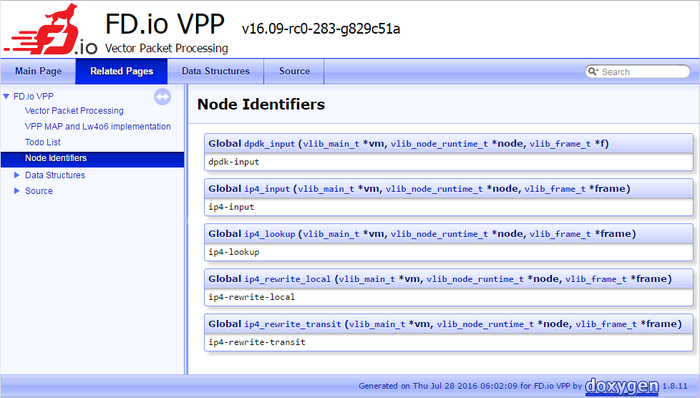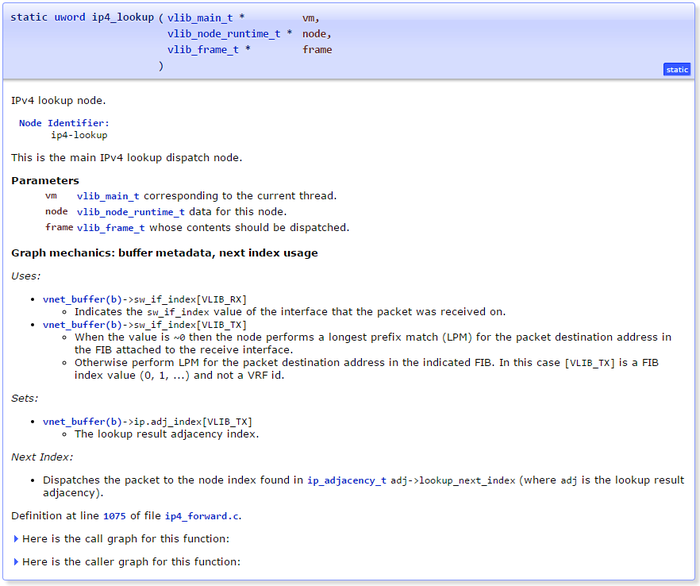Difference between revisions of "VPP/Documentation"
m (typo) |
m (better explanation) |
||
| Line 227: | Line 227: | ||
</pre> | </pre> | ||
| − | This is especially worth noting should you have previously built the documentation for the whole source tree and then want to build it for only one directory or file (using <code>DOXY_INPUT</code>); whilst unlikely, the remnants of previous documentation may interfere with Doxygen runs | + | This is especially worth noting should you have previously built the documentation for the whole source tree and then want to build it for only one directory or file (using <code>DOXY_INPUT</code>); whilst unlikely, the remnants of previous documentation may interfere with subsequent Doxygen runs for a narrower scope. |
Revision as of 16:21, 28 July 2016
The VPP project currently uses Doxygen as the mechanism to generate documentation. This is predominantly focused on providing developer-focused information but it can also be used to generate user-focused details.
Doxygen works by parsing source files and identifying special comment blocks that are adjacent to identifiers in the code. We have Doxygen configured to generate output for items that are not yet documented so that at the very least the names of function parameters or structure members are visible.
This wiki page aims to cover how developers can go about producing documentation. Whilst it will cover a number of Doxygen features, readers are encouraged to review the Doxygen documentation and in particular special commands page.
Documenting the code
What to document
In an ideal world we would document everything; however given the realities here are a list of items that should be prioritized for documenting and where the better the documentation the better able VPP is to mature:
- Graph node functions.
- See the graph node template below.
- Widely-used library functions, structures and pre-processor macros.
- Most of
vppinfraandvlib. -
*_formatand*_unformatfunctions. - FIB and other data interaction mechanisms.
- Most of
- CLI
short_helpandlong_help.- These will eventually be extracted for automatic documentation.
- API definitions.
- At the moment most API documentation just describes the parameters; better description of what API calls do is necessary in many cases.
- Anything else that may be of use to the developer who comes after you.
In general, static and inline functions within modules are not visible outside that module and thus adding a documentation block may be of limited value (with exceptions, such as when used for function pointers for consumption elsewhere); though this does not excuse a developer from writing useful comments. However static and inline functions in header files are much more widely visible and should be documented.
Documentation conventions
To promote consistency both in the VPP source code and in the generated text, these are the conventions VPP have adopted for writing documentation.
Doxygen comments/commands
Doxygen requires the use of specially marked comment blocks to identify documentation and recognizes several special commands inside those blocks. It provides several ways to indicate both of these things. Whilst any will work, VPP as a project has adopted the following as conventions:
- Pre-identifier comment blocks are signified with
/** ... */.- These are documentation blocks that come immediately before the code that they provide documentation for.
- Post-identifier comment blocks are given with
/**< ... */.- These are documentation blocks that come immediately after the code that they provide documentation for.
- In some situations using
///< ...may make the code more readable and this is acceptable.
- Special commands are prefixed with the at-sign, for example
@paramor@brief.- Though you may often find the use of a back-slash in the existing code (especially
\brief) these are being migrated to using at-sign. - Note that the Doxygen documentation will show use of back-slash throughout, but it notes that the two symbols are equal and interchangeable.
- Though you may often find the use of a back-slash in the existing code (especially
Referring to identifiers in the text
Doxygen will automatically spot the names of known functions in the text and link those to the definition of that function. For other identifiers you must tell it to using @ref and this is encouraged in all places; note that not all things are linkable in this way (refer to the Doxygen documentation) but it is harmless to use @ref in such places.
For other items, such as function parameters, local variables or constants the use of @c is recommended. This will mono-space the text thus providing contrast with the surrounding text. Note that this works only for a single word; <tt> ... </tt> can be used for multiple words or @code ... @endcode for a C code block.
Extra commands
These commands have been added to Doxygen (using the ALIAS mechanism) to assist with documenting specific items in a consistent way.
@node: Indexing graph node identifiers
The @node command is used to document the name of graph nodes. The command make use of the Doxygen @xrefitem command to generate an index of graph nodes and renders the name of the node in mono-spaced type in the node documentation.
See below in the node template section for an example of use and how the node name is rendered within the documentation output. The index, when rendered, will look something like this:
Documentation templates
Source code file header
All of our source codes are required to include the Apache 2.0 license preanble. To properly document files they should also contain at minimum a brief description of the contents of that module and preferably a longer description to give some detail on that purpose.
/* * Copyright (c) <current-year> <your-affiliaiton-here>. * * Licensed under the Apache License, Version 2.0 (the "License"); * you may not use this file except in compliance with the License. * You may obtain a copy of the License at: * * http://www.apache.org/licenses/LICENSE-2.0 * * Unless required by applicable law or agreed to in writing, software * distributed under the License is distributed on an "AS IS" BASIS, * WITHOUT WARRANTIES OR CONDITIONS OF ANY KIND, either express or implied. * See the License for the specific language governing permissions and * limitations under the License. */ /** * @file * @brief Your brief description goes here. * * Your much longer description goes here. This should be written in * structurally correct English, with proper capitalization, sentences * and paragraphs. */
An example of the @file section might read:
/**
* @file
* @brief Unix stdin/socket command line interface.
*
* Provides a command line interface so humans can interact with VPP.
* This is predominantly a debugging and testing mechanism.
*/Documenting a graph node function
Nodes form the core of what VPP does and providing meaningful documentation about their function is important. This is doubly so for those nodes which are direct ancestors or descendants of a node a developer is working; that individual will be looking for details on the features the surrounding nodes make available. Examples may include the metadata passed along in the buffer opaque data which will help a node understand where a packet came from. Some nodes will expect data in the opaque section in order to steer their behavior.
By way of example, here is the documentation block for the "ip4-lookup" node and which may be used as a template:
/** * @brief IPv4 lookup node. * @node ip4-lookup * * This is the main IPv4 lookup dispatch node. * * @param vm vlib_main_t corresponding to the current thread. * @param node vlib_node_runtime_t data for this node. * @param frame vlib_frame_t whose contents should be dispatched. * * @par Graph mechanics: buffer metadata, next index usage * <em>Uses:<em> * - <code>vnet_buffer(b)->sw_if_index[VLIB_RX]</code> * - Indicates the @c sw_if_index value of the interface that the * packet was received on. * - <code>vnet_buffer(b)->sw_if_index[VLIB_TX]</code> * - When the value is @c ~0 then the node performs a longest prefix * match (LPM) for the packet destination address in the FIB attached * to the receive interface. * - Otherwise perform LPM for the packet destination address in the * indicated FIB. In this case <code>[VLIB_TX]</code> is a FIB index * value (0, 1, ...) and not a VRF id. * * <em>Sets:<em> * - <code>vnet_buffer(b)->ip.adj_index[VLIB_TX]</code> * - The lookup result adjacency index. * * <em>Next Index:</em> * - Dispatches the packet to the node index found in * ip_adjacency_t @c adj->lookup_next_index * (where @c adj is the lookup result adjacency). */ static uword ip4_lookup (vlib_main_t * vm, vlib_node_runtime_t * node, vlib_frame_t * frame) { ... }
When rendered, this documentation block will look something like this:
Of particular note this example describes these things:
- The node name is documented with the special "
@node" command. This is an alias we have configured in Doxygen that provides a central index of node definitions. - A description of what extra data it uses as inputs; in this case the text describes how
ip4-lookupmakes use ofvnet_buffer(b)->sw_if_index[VLIB_RX]andvnet_buffer(b)->sw_if_index[VLIB_TX]. - A description of what extra data is passes on to descendants; in this case
vnet_buffer(b)->sw_if_index[VLIB_TX]. - A description of how the next node index is determined.
In this case the bulk of the node functionality can be described in terms of the sw_if_index sections; other nodes may need to provide more verbiage in other sections of the text. In particular, where nodes have other side-effects those should be clearly documented.
Build tools
All documentation generation related dependencies are installed with the install-dep target of the top level Makefile.
Building the documentation
The top level Makefile of the VPP build tree also includes a doxygen build target that will run Doxygen over the complete VPP source tree. Invoking that target will produce a significant amount of output and would look something like this:
$ make doxygen Adding custom extension mapping: .def will be treated as language c Adding custom extension mapping: .api will be treated as language c Parsing layout file /home/chrisy/dev/fdio/vpp/doxygen/layout.xml... Searching for include files... Searching for files in directory /home/chrisy/dev/fdio/vpp/vppinfra Searching for files in directory /home/chrisy/dev/fdio/vpp/vppinfra/autom4te.cache Searching for files in directory /home/chrisy/dev/fdio/vpp/vppinfra/config ... Patching output file 10218/10219 Patching output file 10219/10219 lookup cache used 25684/65536 hits=502842 misses=26575 finished...
Previewing the generated documentation
By default only HTML documentation is produced and it is built in build-root/docs/html. If you build the documentation on a workstation then you can simply open index.html in that directory with a web browser to view it, for example:
$ make doxygen ... $ sensible-browser build-root/docs/html/index.html
Alternatively if you run this on a remote machine then an approach might be to add an HTTP server (such as Nginx or Apache HTTPD) to that host and configure it to expose the build-root/docs/html directory; one mechanism is to symbolically link to this directory from inside some other directory already visible from the HTTP server, assuming the use of symbolic links is allowed. Details on this are beyond the scope of this page.
Building documentation for a specific directory or file
Producing the documentation for the entire build tree can take some time which can become an issue if a developer is working on documentation for a specific module or directory tree. As a convenience it is possible to override the set of directories into which Doxygen will descend when searching for files to parse. For example:
$ make doxygen DOXY_INPUT=vppinfra
or, if you wanted just one file:
$ make doxygen DOXY_INPUT=vppinfra/vppinfra/pool.h
Cleaning up after Doxygen
It is also possible to clean up the Doxygen output directory. This can become useful since Doxygen does not itself remove files from the build directory on subsequent runs should they become redundant.
$ make wipe-doxygen
This is especially worth noting should you have previously built the documentation for the whole source tree and then want to build it for only one directory or file (using DOXY_INPUT); whilst unlikely, the remnants of previous documentation may interfere with subsequent Doxygen runs for a narrower scope.

